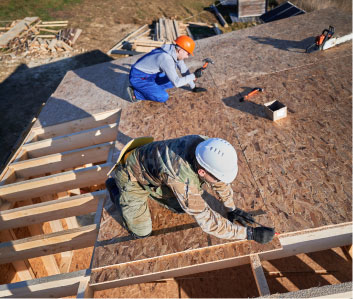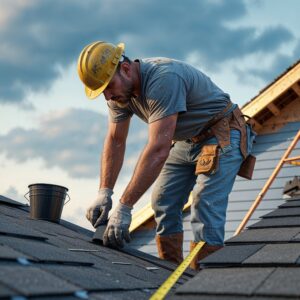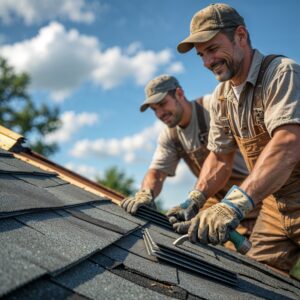Roof tiling, slating, thatching, and felting are the most common roofing techniques, depending on the material being installed.
Selecting the right roofing technique is required for the long-term resilience and aesthetic of the building. It involves various methods that suit different architectural styles and climates, bringing unique benefits to infrastructure. The most commonly used roofing techniques include tiling for overlapping tiles made from materials like clay or concrete, slating to employ thin and flat slate pieces, and felting for layering felt and bitumen to create a waterproof barrier. On the other hand, thatching is an ancient technique still used in some regions to install roofs with dried vegetation.
Modern and Traditional Roofing Techniques that Suits Every Architectural Style
Several roofing techniques offer distinct benefits and aesthetic appeal to your home. They are used to install specific types of roofing material. Understanding these methods helps homeowners choose the right option according to their home’s architectural style, budget considerations, and desired aesthetics.
| Technique | Key material | Best for | Benefits |
| Roof Tiling | Clay, concrete or ceramic tiles | Moderate and warm climates, traditional styles | Durable, weather-resistant |
| Roof Slating | Natural slate | Historic homes and high-end designs | Longer lifespan, low maintenance needs |
| Roof Thatching | Straw, reeds or heather | Rural or rustic buildings | Natural insulation, aesthetic charm, eco-friendly |
| Roof Shingling | Asphalt or wood | Residential homes seeking a traditional or aesthetic appeal | Affordable, easy installation, versatile design option |
| Roof EPDM | Synthetic rubber | Flat and low-slope roofed homes | Cost-effective, low-maintenance, excellent waterproofing properties |
| Roof Felting | Fiberglass or organic Felt sheets with adhesive or bitumen coating | Underlayment for various roofing types | Moisture protection, cost-effective, easy installation, low maintenance |
Roof Tiling | Distinctive and Durable
Roof tiling is a popular roofing method that involves using clay or concrete tiles to create a durable and aesthetically pleasing roof. This technique has been utilised for centuries and is known for its longevity and resilience against various weather conditions. Tiling is designed to interlock or overlap, creating a secure or robust barrier. This protective layering over residential and commercial buildings makes the roof tiles the preferred choice for various architectural styles and climates.
Characteristics
- The primary materials used in roof tiling include:
- Clay tiles— Known for their natural beauty and durability. They are often used in traditional and Mediterranean-style homes.
- Concrete tiles— More affordable than clay. They can mimic the appearance of other materials and offer excellent durability.
- Roof tiles come in various colors, shapes, and profiles (flat, round, or textured). This allows homeowners to customise the style that complements their home’s architecture.
- Roof tiling can withstand extreme weather conditions, including high winds (up to 150 mph), hail and fire. It has a long lifespan if properly maintained.
Benefits
- Can last over 100 years, making roof tiles the most durable roofing technique.
- Non-combustible and have a class A fire rating.
- Prevent damage due to heavy winds and extreme temperatures.
- Air gap under tiles provides natural insulation.
- Requires minimal upkeep and can be easily replaced without a whole re-roof.
Installation
- Tiling roofs requires careful planning and skilled labour. The process typically begins with preparing the roof deck and ensuring it is structurally sound.
- Start at the bottom edge of the roof and secure the first row of tiles.
- Overlap each subsequent row of tiles over the previous one to ensure proper water drainage.
- Use nails or clips to secure each tile.
- Cut tiles as necessary to fit around chimneys, vents or other protrusions. Apply roofing sealant to create watertight seals around these areas.
- While finishing, install ridge caps along the peak of the roof.
- Conduct final inspection and ensure tiles are properly aligned.
Roof Slating | Elegant and Timeless Appeal
Roof slating is a traditional roofing technique that utilises natural slate tiles to create a robust and visually appealing structure. Slate is a metamorphic rock that can be split into thin sheets, making it ideal for roofing applications. Due to its elegance and beauty, slating is considered the more premium and luxurious option for various architectures in Europe, whether for historic buildings or modern homes.
Characteristics
- Slate is a natural, fine-grained stone mined and cut into shingles. They come in various thicknesses, colours and textures.
- Roof slating is relatively heavy compared to other materials, which may require structural support in the building.
- Slates have low water absorption rates that allow them to withstand freezing temperatures without cracking.
- These roofs typically feature a distinctive layered appearance with tiles installed in an overlapping pattern to avoid water standing.
Benefits
- Durable as much as clay tiles with a lifespan of 100+ years.
- Excellent resistance to harsh environments, whether heavy storms or high degrees.
- Naturally fire-resistant enhances the safety of the structure.
- Low maintenance needs, occasional inspection for cracks or loose tiles.
- Highly effective against mould, moss or pests
- Enviro-friendly, being natural and recyclable.
- Increase the house’s visual appeal and resale value.
Installation
- Nail fixing ensures all the slates are pre-holed using a machine for accuracy. Strike chalk lines from the eaves to the ridge at half-slate intervals for alignment. Position each slate so that its head overlaps with the batten below. Use copper nails with appropriate dimensions to secure each slate through pre-drilled holes.
- Hook fixing eliminates the need for holing. Stainless steel hooks secure the slate at their tails, providing better resistance against wind uplift.
Consider hiring a roofing specialist due to the slate material’s weight and the precision needed for alignment. Roof slating can be done by nail fixing or hook fixing methods.
Roof Felting | Functional, Typically Not Visible
Roof felting is often referred to as “tar paper.” It is a protective layer installed beneath the primary roofing material to prevent moisture. Felting is made from a base material such as cellulose fibres or polyester infused with asphalt to serve multiple purposes and improve the overall durability of the roofing system. It has been a standard component in roofing installations for many years due to its effectiveness and cost-efficiency.
Characteristics
- Roof felting comes in different weights and thicknesses, usually measured in pounds per square.
- These tar papers are typically rolled out in large sheets and can be either mechanically fastened or adhered to using adhesives.
- The material is designed to be durable, resistant to tearing, and withstand exposure to moisture, making it an effective protective layer beneath roofing materials.
- Felting comes in two types: breathable (allows moisture vapour to escape while preventing water ingress) or non-breathable ( a robust barrier against moisture to escape).
- The surface of roof felting can be sandpaper-like or smooth, depending on the product used.
Benefits
- Helps absorb and wick away excess moisture, reducing the risk of mould in the attic.
- Increases fire safety rating of the roof system to achieve a class A fire rating.
- Smooth out the surface beneath the shingles to prevent visible lines from the decking.
- Provides a safer walking surface during installation or maintenance compared to bare plywood.
- Affordable compared to other materials.
- Extend the life span of the roof by protecting it from external damage.
Installation
- Install drip edge flashing along the eaves of the roof to direct water away from the structure and prevent seepage underneath.
- Roll out the felt starting from one edge of the roof deck.
- Secure it with nails or staples every 4-8 inches along the edges and seams.
- Overlap each subsequent row by 2-3 inches to ensure complete coverage.
- Cut and fit the felt around vent pipes and chimneys for a tight seal.
- Continue laying felt up to the peak of the roof, overlapping at seams for maximum protection.
Roof Thatching | Rustic and Traditional
Thatching is a time-honoured roofing technique that combines aesthetic charm with functional benefits. This method uses dry vegetation such as straw, water, reed, rushes, or sedges to create a weather-resistant covering for buildings. Roof thatching is an ancient technique prevalent in various cultures worldwide for its insulating properties and sustainability as a natural building material. It is particularly associated with rural architecture in the UK and other parts of Europe.
Characteristics
- Thatching material varies based on local availability and tradition. The most common types include:
- Water reed– Known for its durability and longevity, often used in wetland areas. It provides a straighter appearance for 60 years.
- Combed wheat reed— a byproduct of grain production. This offers a more rounded look and typically lasts around 25-35 years.
- Longstraw— Similar to combed wheat but applied with both ends facing downwards, resulting in a shaggy appearance. Its lifespan is generally 15-25 years.
- Thatched roofs are built on a framework of timber rafters and battens. They are characterised by their thick layers of materials, which are shaped to create a sloped surface for easy rainwater runoff.
- The installation methods can differ significantly, with techniques such as rope, pinned and thrust thatch being used in different regions.
Benefits
- Longevity depends on the material used, typically around 15 to 60 years.
- Excellent thermal insulation due to the air pockets within the material.
- Offers a charming and rustic appearance to add classic character to the building.
- Made from renewable resources.
- Relatively lightweight, requiring less structural support.
Installation
- Begin by layering the base of thatch material, working from the eaves upward. All layers should overlap each other.
- Use traditional fasteners such as hazel spars or modern alternatives like metal fixings.
- Construct the ridge with either a wrap-over or butt-up method.
- Shape eaves and verges with decorative elements.
- Regular inspection is necessary for thatched roofs.
Roof EPDM | Practical But Less Aesthetic Appeal
Ethylene Propylene Diene Monomer roofing is a type of synthetic rubber membrane widely used for flat and low-slope roofs. This roofing technique is highly durable and popular for residential and commercial applications.
Characteristics
- EPDM is made from two primary ingredients–ethylene and propylene–derived from oil and natural gas. This composition gives it excellent resistance to heat, ozone and weathering.
- EPDM membranes are available in large sheets of black and white, with widths ranging from 7.5 to 50 feet and thicknesses of 45 to 90 mils.
- This roofing option can be easily installed and can last up to 50 years with regular maintenance
Benefits
- Resistant to UV radiation, hail and extreme conditions.
- Less expensive to install than TPO or PVC.
- Minimise potential leak points and simplify repairs.
- Effective waterproofing capabilities for flat roofs.
- Adapts well to different roof shapes.
Installation
- Begin with suitable underlayment if necessary.
- Roll out the EPDM membrane to ensure it covers the whole roof with minimal seams.
- Secure with suitable adhesive according to instructions.
- Apply appropriate sealants to the edges and seams for a watertight installation.
- Trim any excess membranes around obstacles.
Roof Shingling | Range of Styles in Budget-Friendly Costs
Shingling is a widely used roofing method that involves laying asphalt, wood and metal shingles in overlapping rows to create a protective covering for buildings. This technique starts from the bottom edge of the roof and works upwards, a relatively straightforward approach to offer unique benefits and styles.
Characteristics
- The most common types of shingles include
- Asphalt— made from fibreglass mats coated with granules and asphalt. They are affordable and easy to install.
- Wood— made from cedar or other types of wood, provides a natural look but requires more maintenance.
- Metal—Durable and lightweight, available in various styles that mimic traditional roofing materials.
- Install overlapping patterns to ensure water flows off the roof rather than penetrating through seams.
Benefits
- Offers different durability, e.g., asphalt lasts 20-30 years while slate performs well for up to 100 years.
- Protection against rain, wind, and snow.
- Numerous colours and styles enhance a building’s curb appeal.
- Some options are more affordable upfront than other materials.
- Metal and certain asphalt types reduce cooling costs by reflective sunlight.
- Prevent leaks and protect the home’s interior.
- Easy to install, suitable for DIY projects or quick, professional process.
Installation
- Start with a starter course of shingles at the roof’s edges to ensure overhang the drip slightly.
- From one corner of the roof, lay the first course to nail them securely in place.
- Use four nails per shingle for stability.
- Stagger the seams by cutting the first shingle of every other row to create a pattern.
- Repeat this process for subsequent courses, alternating between full and cut shingles to increase water resistance.
- Cap the ridge for a finished appearance.
Conclusion:
Many common roofing techniques ensure high durability and aesthetic appeal to your home. Each offers different features and benefits, whether you want the traditional charm of thatching, the durability of tiling or the classic appeal of slating. These roofing methods resist weather elements and create a protective barrier between you and the environment, keeping the indoors safe.




